Empire line: all roads lead to Rome for Studio Formafantasma’s new work

When it came to designing a new collection for Rome’s Galleria O, Andrea Trimarchi and Simone Farresin returned to their native Italy as wide-eyed sightseers. ‘We visited literally every archeological site and museum in Rome,’ laughs the 35-year-old, Veneto-born Farresin, who is one half of the Netherlands-based duo known as Studio Formafantasma. ‘We rented bikes and did exactly what the tourists do.’
While most tourists might return home with a couple of selfies after a few days of site-bingeing at the Forum, the Coliseum and everything in-between, Trimarchi and Farresin came back to their studio in Amsterdam armed with a 20-piece design collection, including coffee tables, a bookshelf, a cabinet, bowls, tabletop objects and lamps that were inspired by Rome and produced by the city’s specialised artisans. The duo, who first met at the Istituto Superiore per le Industrie Artistiche in Florence and later attended the prestigious Design Academy Eindhoven together, likened the Rome project to a ‘student semester abroad’ and see it as a return to their Italian roots. ‘When you grow up in Italy, you’re surrounded by all these museums,’ says 32-year-old Trimarchi, who hails from Sicily. ‘But you’re bored by it and don’t realise its value. So we had the opportunity to rediscover our past.’
Commissioned by Galleria O’s Roberto Giustini and Emanuela Nobile Mino, and curated by the MAXXI museum’s Domitilla Dardi, the Delta collection is the latest installment of Privato Romano Interno, a Galleria O initiative that invites international creatives to design objects linked with Rome that are then produced by the city’s craftsmen. The initiative debuted with the Campana Brothers’ Brazilian Baroque collection in 2011. Konstantin Grcic was tapped next and has been toiling for the last three years on a cement installation in a deserted garage in Rome, set to debut later this autumn. In the meantime, the Formafantasma boys came down to Rome and got their collection up and running in a year.
‘We’ve been following Andrea and Simone since 2012, when we first saw their [Craftica] project with Fendi at Design Miami/Basel,’ says Nobile Mino, curator of Privato Romano Interno. ‘We were very interested in their research. They are very focused on materials and a high level of artisan work.’
Trimarchi and Farresin are indeed maniacs for materials and the very specific choice of medium is a laborious process that normally presents a jumping-off point for an entire collection. Once they settle on a material, the designers spend months tinkering and experimenting with it, until its conventional form and function have been erased and recast. Such dissection has resulted in a superb and unusual body of work, including last year’s De Natura Fossilium collection (W*182), in which volcanic rock from Mount Etna was transformed into, among other things, coloured glass on sleek tables and stools. In the past, the pair have created vases from a biomaterial based on the bread used in Sicilian religious festivals, and a collection of vases and bowls made from polymers they developed themselves using plant and animal derivatives. The Rome project, however, presented a departure from their typical working process. Here, they began with the city itself. They became obsessed with the glory of ancient imperial Rome and the sobriety of the Fascist-era rationalist architecture that occurred 1,500 years later. ‘We found amazing ceramics and jewellery [from ancient Rome],’ says Trimarchi. ‘We couldn’t even imagine how skilled the Romans were or how they produced these pieces 200 years before Christ!’
The Delta collection’s small objects, including vessels to pour oil and vinegar, seem pulled right from the elegant banquet tables of an ancient Roman villa. But the designers have given the handles knife-sharp straight lines and produced them in delicate porcelain in minimal black, white, grey and red (a notoriously difficult shade to get right in porcelain), rather than earthy terracotta. They also got rid of the rounded bottoms ubiquitous on ancient upper-class earthenware designs – they had servants to hold and pour them – and made modern objects to stand alone.
The city’s rationalist architecture, including the magnificent Accademia di Scherma, designed by Luigi Moretti in 1934, provided the cue for the collection’s rigorous lines and elegant simplicity, while local craftsmen obliged in the production. ‘They’re all small artisans who were working separately,’ says Trimarchi of the network they used. ‘But now they’re all collaborating together and loving it. That’s the great part about our job – engaging with people, artisans in general, and Italians in particular.’
The designers largely employed materials endemic to Rome. Bronze was used on spider-thin table legs; malachite stone features as a huge lime-sized screw on table frames; while travertine was used for the tops. ‘Rome is basically covered in travertine,’ explains Farresin. ‘A lot of people grow up hating it. But I think it’s beautiful – the fantastic light you find in Rome is from the sun reflecting off its surface.’
Travertine was also used for lighting design, a field the designers embraced for the first time. Composed of a travertine disc with a silver slit and a matching LED disk, one lamp looks like a lunar eclipse suspended on wire cables. Another design, inspired by a Roman helmet, recalls an abstract Brâncuși sculpture.
‘It’s the first collection that is really design-y,’ remarks Trimarchi, explaining that the duo focused on controlling form and shape, rather than working on the production process.
‘Every designer has their realm,’ adds Farresin. ‘Patricia Urquiola is all about couches. We have always been about tableware. We do like objects. We think you need to design tools, things that last a long time. But we also like expanding a bit.’
As originally featured in the October 2015 issue of Wallpaper* (*199)
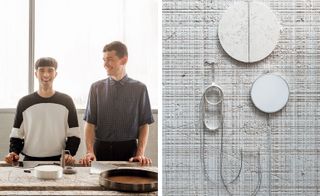
Pictured left: designers Andrea Trimarchi and Simone Farresin with pieces from the 'Delta' collection, in the workshop of TuttoMarmo, the Roman marble specialist that helped produce them. Right: the travertine and silver components of the 'Delta II' lamp, one of Studio Formafantasma's first lighting designs, ready to be assembled

The project also includes tableware, such as the 'Delta I' oil and vinegar pourers in unglazed porcelain

'Delta VIII' coffee table in travertine, scorched brass and malachite, in the TuttoMarmo workshop
INFORMATION
'Delta' by Studio Formafantasma, available now at Galleria O, Rome. For more information, visit Formafantasma's website
Wallpaper* Newsletter
Receive our daily digest of inspiration, escapism and design stories from around the world direct to your inbox
JJ Martin
-
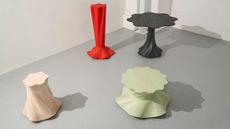 AHEC presents new works in American maple as part of the Wallpaper* Class of ’24
AHEC presents new works in American maple as part of the Wallpaper* Class of ’24The American Hardwood Export Council takes part in the Wallpaper* Class of ’24 exhibition at Triennale Milano during Salone del Mobile (16-21 April 2024), presenting new pieces by Parti and Giles Tettey Nartey in American hard maple
By Rosa Bertoli Published
-
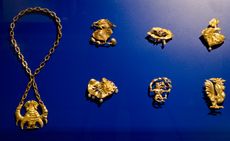 Paris’s Musée des Arts Décoratifs celebrates avant-garde jewellery design
Paris’s Musée des Arts Décoratifs celebrates avant-garde jewellery design'Fashion, Design, Jewellery Exhibit' is the new transdisciplinary exhibition at Paris’s Musée des Arts Décoratifs
By Minako Norimatsu Published
-
 Dip into Janu Tokyo hotel, Aman’s sociable new sibling brand
Dip into Janu Tokyo hotel, Aman’s sociable new sibling brandStep inside the Jean-Michel Gathy-designed Janu Tokyo and discover its state-of-the-art wellness facilities
By Jens H Jensen Published
-
 Triennale Milano exhibition spotlights contemporary Italian art
Triennale Milano exhibition spotlights contemporary Italian artThe latest Triennale Milano exhibition, ‘Italian Painting Today’, is a showcase of artworks from the last three years
By Tianna Williams Published
-
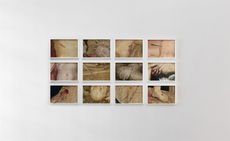 Walls, Windows and Blood: Catherine Opie in Naples
Walls, Windows and Blood: Catherine Opie in NaplesCatherine Opie's new exhibition ‘Walls, Windows and Blood’ is now on view at Thomas Dane Gallery, Naples
By Amah-Rose Abrams Published
-
 Sculptor Arnaldo Pomodoro transforms Fendi’s Rome HQ into a theatre of myth and magic
Sculptor Arnaldo Pomodoro transforms Fendi’s Rome HQ into a theatre of myth and magicFendi’s Roman HQ sets the scene for ‘Il Grande Teatro delle Civiltà’ a major show by Italian sculptor Arnaldo Pomodoro, who has also created a one-off edition of the house’s iconic Peekaboo bag. Read more in the July 2023 Issue of Wallpaper*, on newsstands 8 June
By Harriet Lloyd-Smith Published
-
 Raffaele Salvoldi stacks hundreds of marble blocks for dazzling Milan installation
Raffaele Salvoldi stacks hundreds of marble blocks for dazzling Milan installationFor a Milan Design Week 2023 installation, Italian artist Raffaele Salvoldi teams up with marble brand Salvatori to create architectural sculptures comprising hundreds of marble blocks
By Harriet Lloyd-Smith Published
-
 Venice Biennale 2022 closing review: who, how and what on earth?
Venice Biennale 2022 closing review: who, how and what on earth?As the sun sets on the 59th Venice Art Biennale (until 27 November), we look back on an edition filled with resilience, female power and unsurprisingly, lots of surprises
By Harriet Lloyd-Smith Published
-
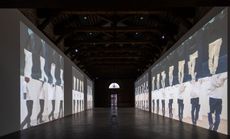 Bruce Nauman’s Venice mega-show is a full body experience
Bruce Nauman’s Venice mega-show is a full body experienceFocusing on the American artist's performative 'Contrapposto Studies', Bruce Nauman's show at Punta della Dogana, Venice, gives new meaning to body language – on view until 27 November 2022
By Laura May Todd Published
-
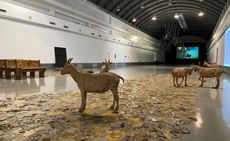 Biennale Arcipelago Mediterraneo: reflections on Sicily’s history and futures
Biennale Arcipelago Mediterraneo: reflections on Sicily’s history and futuresOpening against the backdrop of Italy’s snap general election, the third edition of the Biennale Arcipelago Mediterraneo in Palermo ruminates on past and present global conflicts, interwoven with stories from the Mediterranean
By Hili Perlson Last updated
-
 Mitico: art, luxury hospitality and home cooking collide in Italy
Mitico: art, luxury hospitality and home cooking collide in ItalySpearheaded by the Belmond hotel group and Galleria Continua, new initiative Mitico introduces the work of four major artists on the grounds of four iconic Italian hotels
By Amy Serafin Last updated